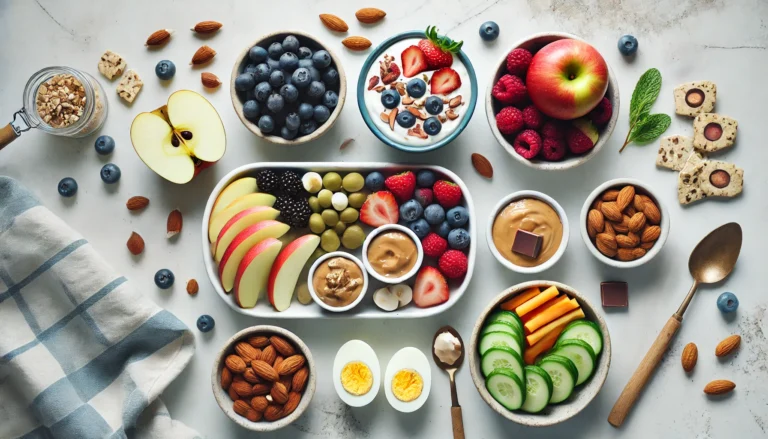What Does Cottage Cheese Taste Like? 2 Best Brands to Try
What does cottage cheese taste like? If you’ve ever wondered about this creamy dairy delight, you’re not alone. Cottage cheese offers a unique flavor profile—mildly tangy, slightly sweet, and incredibly versatile, making it a favorite in both savory and sweet dishes.
Thank you for reading this post, don't forget to subscribe!In this guide, we’ll explore the tastes and nutrition of two top cottage cheese brands, Knudsen and Good Culture. Whether you’re a newcomer or a cottage cheese enthusiast, this post will help you understand what makes these brands stand out in flavor and health benefits.
Discover the Best Brands: Knudsen & Good Culture Cottage Cheese
Have you ever stood in the dairy aisle, staring at the cottage cheese section, wondering if it’s worth adding to your shopping cart? You’re not alone. Whether you’re new to cottage cheese or you’ve had it on your plate for years, understanding its flavor, texture, and nutritional benefits can make all the difference in your meal planning.
In this guide, we’ll explore two of the top cottage cheese brands—Knudsen and Good Culture—highlighting their distinct flavors and nutritional profiles. If you’ve been curious about what cottage cheese tastes like, or what makes these brands stand out, you’re in the right place. This post will help you make an informed decision, whether you’re looking for a healthier option or simply want to discover which cottage cheese best fits your taste preferences.


What Does Cottage Cheese Taste Like?
Cottage cheese taste can be a bit of an enigma for many people. It’s not quite like any other dairy product, with a unique flavor profile that varies depending on the fat content and processing method. In general, cottage cheese has a mild, slightly tangy flavor, with a smooth, creamy texture that can also have small curds, offering a bit of a bite.
Cottage Cheese Taste – Mild, Tangy, and Creamy
The cottage cheese taste is often described as tangy, but the level of tanginess can vary. The lower the fat content, the more pronounced the tangy notes tend to be. Full-fat versions, on the other hand, have a richer, creamier flavor, which is often described as more neutral and milder in taste. If you’re new to cottage cheese, starting with a full-fat version like Knudsen or Good Culture might make it easier to appreciate, especially when paired with sweet or savory toppings.
Texture and Consistency
Cottage cheese comes in different textures, depending on how much it’s been drained. The curds can range from small to large, and the liquid (whey) may vary. The larger the curds, the more “bite” you’ll get with each spoonful. The consistency can also be smoother if it’s been blended or whipped.
As you venture into the world of cottage cheese, the texture might surprise you. Some brands, like Good Culture, offer a more velvety texture, while others, like Knudsen, have more pronounced curds.


Cottage Cheese Nutrition Basics
When choosing cottage cheese, the nutritional profile is key. This simple dairy product can pack a powerful punch in terms of protein, calcium, and probiotics.
Nutritional Breakdown of Cottage Cheese
In terms of basic nutrition, here’s a quick overview of what you’ll typically find in cottage cheese:
- Protein: A great source of protein, making it ideal for muscle repair and a satisfying snack.
- Carbs: Low in carbs, making it a favorite for people on low-carb or keto diets.
- Fat: The fat content varies. Full-fat options provide more calories, while low-fat or fat-free versions keep things lighter.
- Calories: Depending on the fat content, cottage cheese is relatively low in calories, making it an easy snack choice without guilt.
Knudsen Cottage Cheese Nutrition vs. Good Culture
- Knudsen Cottage Cheese: Knudsen’s version is made with whole milk or 2% milk, offering a rich, creamy texture and a smooth, mild taste. It typically contains about 120 calories per half-cup serving, with 4-5 grams of fat and 10-12 grams of protein.
- Good Culture Cottage Cheese: Known for its probiotic-rich formula, Good Culture offers organic cottage cheese made from high-quality ingredients. It’s a bit higher in protein (about 14-15 grams per serving) and contains live and active cultures that promote gut health.


Knudsen Cottage Cheese
A History of Quality and Flavor
Knudsen Cottage Cheese has been around for over 100 years, providing consumers with high-quality, flavorful dairy products. Its creamy texture and mild taste have made it a staple in households across America. What sets Knudsen apart is its careful process of making cottage cheese from fresh milk, resulting in a rich flavor that pairs well with both savory and sweet dishes.
Taste and Texture of Knudsen Cottage Cheese
Knudsen Cottage Cheese is known for its smooth consistency with small, delicate curds. The full-fat version has a silky, cream-like texture that melts in your mouth, while the 2% version still maintains that delightful richness. The flavor is subtle, slightly sweet, and not as tangy as some other brands, making it an approachable option for first-timers.
Knudsen Cottage Cheese Nutrition Facts
| Serving Size | Calories | Protein | Fat | Carbs |
|---|---|---|---|---|
| ½ cup | 120 | 12g | 5g | 4g |


Good Culture Cottage Cheese Nutrition
Organic, Probiotic-Powered Good Culture
Good Culture Cottage Cheese brings something special to the table. With a commitment to organic ingredients and a focus on gut health through probiotics, Good Culture offers a more health-conscious take on cottage cheese. It’s the perfect choice for those looking to combine nutrition with flavor.
Why Choose Good Culture?
Good Culture cottage cheese is unique because it’s packed with probiotics that can support digestive health. Additionally, the high protein content makes it an excellent option for those on a high-protein diet or looking to fuel up post-workout. The texture of Good Culture is smooth and velvety, with a richer consistency compared to traditional cottage cheese. You’ll notice that it’s a bit tangier than some other brands, but this adds to its refreshing, creamy flavor.
Good Culture Cottage Cheese Nutrition Facts
| Serving Size | Calories | Protein | Fat | Carbs |
|---|---|---|---|---|
| ½ cup | 110 | 14g | 5g | 4g |


Best Cottage Cheese Brands
When it comes to choosing the best cottage cheese, there’s a lot of variety. Based on expert recommendations and user reviews, two brands stand out for their flavor and nutritional benefits:
- Knudsen Cottage Cheese: Known for its creamy texture and subtle, sweet taste, Knudsen is a go-to for many. It’s versatile, affordable, and perfect for both sweet and savory dishes.
- Good Culture Cottage Cheese: This brand stands out for its organic ingredients and the inclusion of probiotics. If gut health and protein intake are your priorities, Good Culture is a fantastic option.


How to Enjoy Cottage Cheese
There’s no wrong way to enjoy cottage cheese, but how you serve it can dramatically change its taste and appeal. Whether you’re a cottage cheese novice or a seasoned fan, there are a variety of ways to enhance its flavor to suit your preferences.
Savory or Sweet?
For those new to cottage cheese, it’s great to try both savory and sweet options. Pairing cottage cheese with:
- Fresh Fruit: A drizzle of honey and berries can transform the taste, creating a delicious, creamy, and tangy snack.
- Veggies: For savory lovers, try mixing in cucumbers, tomatoes, or even a dash of sea salt and pepper.
- Nuts and Seeds: For added crunch and nutrition, sprinkle a few chopped almonds or chia seeds on top.
For Beginners
If you’re hesitant about the cottage cheese taste, starting with a sweeter topping might be the easiest way in. You can also try mixing it with yogurt or a bit of granola to mask the tanginess, making it an enjoyable snack even for those not initially fond of it.


Conclusion
Cottage cheese can be both nutritious and delicious when chosen wisely. Whether you opt for the creamy Knudsen cottage cheese or the probiotic-packed Good Culture, both brands bring something special to your table. If you’ve been wondering what does cottage cheese taste like, now you know—it’s a versatile, tangy dairy with a creamy texture, perfect for both savory and sweet dishes. So next time you’re looking for a healthy snack or a protein-packed addition to your meals, reach for a tub of cottage cheese!
FAQ
1. What does cottage cheese taste like?
Cottage cheese has a mild, tangy flavor, with a smooth and creamy texture. The taste varies depending on the fat content, with full-fat versions being milder and creamier.
2. Is Knudsen cottage cheese healthy?
Yes! Knudsen cottage cheese is a good source of protein, calcium, and essential vitamins. It’s a nutritious option for a healthy snack or meal addition.
3. Good Culture cottage cheese nutrition facts?
Good Culture is packed with probiotics, offering around 14 grams of protein and 110 calories per ½ cup serving. It’s made with organic ingredients for an extra health boost.
4. How to make cottage cheese taste better?
Add fresh fruits, veggies, nuts, or spices to enhance the flavor. You can also try mixing it with yogurt or honey for a sweeter version.
5. Which tastes better — Knudsen or Good Culture?
The taste depends on personal preference. Knudsen is milder and creamier, while Good Culture has a tangier, probiotic-rich flavor that’s great for health-conscious individuals.
Disclaimer:
This post may contain affiliate links. If you purchase through them, we may earn a small commission at no extra cost to you. Also, this content is for informational purposes only and does not substitute professional medical advice.


